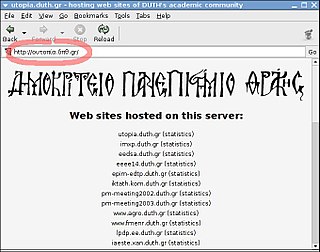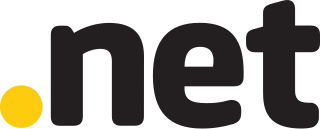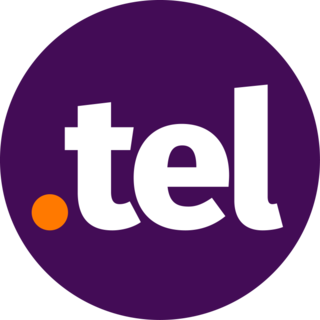
The Internet Corporation for Assigned Names and Numbers is a global multistakeholder group and nonprofit organization headquartered in the United States responsible for coordinating the maintenance and procedures of several databases related to the namespaces and numerical spaces of the Internet, ensuring the Internet's stable and secure operation. ICANN performs the actual technical maintenance work of the Central Internet Address pools and DNS root zone registries pursuant to the Internet Assigned Numbers Authority (IANA) function contract. The contract regarding the IANA stewardship functions between ICANN and the National Telecommunications and Information Administration (NTIA) of the United States Department of Commerce ended on October 1, 2016, formally transitioning the functions to the global multistakeholder community.

In the Internet, a domain name is a string that identifies a realm of administrative autonomy, authority or control. Domain names are often used to identify services provided through the Internet, such as websites, email services and more. Domain names are used in various networking contexts and for application-specific naming and addressing purposes. In general, a domain name identifies a network domain or an Internet Protocol (IP) resource, such as a personal computer used to access the Internet, or a server computer.
The domain com is a top-level domain (TLD) in the Domain Name System (DNS) of the Internet. Created in the first group of Internet domains at the beginning of 1985, its name is derived from the word commercial, indicating its original intended purpose for subdomains registered by commercial organizations. Later, the domain opened for general purposes.

The domain name .org is a generic top-level domain (gTLD) of the Domain Name System (DNS) used on the Internet. The name is truncated from 'organization'. It was one of the original domains established in 1985, and has been operated by the Public Interest Registry since 2003. The domain was originally "intended as the miscellaneous TLD for organizations that didn't fit anywhere else." It is commonly used by non-profit organizations, open-source projects, and communities, but is an open domain that can be used by anyone. The number of registered domains in .org has increased from fewer than one million in the 1990s, to ten million in 2012, and held steady between ten and eleven million since then.

An internationalized domain name (IDN) is an Internet domain name that contains at least one label displayed in software applications, in whole or in part, in non-Latin script or alphabet or in the Latin alphabet-based characters with diacritics or ligatures. These writing systems are encoded by computers in multibyte Unicode. Internationalized domain names are stored in the Domain Name System (DNS) as ASCII strings using Punycode transcription.
A domain name registrar is a company, person, or office that manages the reservation of Internet domain names.

The domain name net is a generic top-level domain (gTLD) used in the Domain Name System of the Internet. The name is derived from the word network, indicating it was originally intended for organizations involved in networking technologies, such as Internet service providers and other infrastructure companies. However, there are no official restrictions and the domain is now a general-purpose namespace.
.museum is a sponsored top-level domain (sTLD) in the Domain Name System of the Internet used exclusively by museums, museum associations, and individual members of the museum profession, as these groups are defined by the International Council of Museums (ICOM).
A country code top-level domain (ccTLD) is an Internet top-level domain generally used or reserved for a country, sovereign state, or dependent territory identified with a country code. All ASCII ccTLD identifiers are two letters long, and all two-letter top-level domains are ccTLDs.

.ae is the country code top-level domain (ccTLD) in the Domain Name System of the Internet for the United Arab Emirates. It is administered by .aeDA which is part of the Telecommunications and Digital Government Regulatory Authority of UAE (TDRA).

.ai is the Internet country code top-level domain (ccTLD) for Anguilla, a British Overseas Territory in the Caribbean. It is administered by the government of Anguilla.

.tw is the Internet country code top-level domain (ccTLD) for Taiwan. The domain name is based on the ISO 3166-1 alpha-2 country code TW. The registry is maintained by the Taiwan Network Information Center (TWNIC), a Taiwanese non-profit organization appointed by the National Communications Commission (NCC) and the Ministry of Transportation and Communication. Since 1 March 2001, TWNIC has stopped allowing itself to sign up new domain names directly, instead allowing new registration through its contracted reseller registrars. As of May 2023, there are 17 registrars.

.gr is the country code top-level domain (ccTLD) for Greece. Registrations are processed via accredited registrars and domain names in Greek characters may also be registered.

The domain name .tel is a top-level domain (TLD) in the Domain Name System (DNS) of the Internet. It was approved by ICANN as a sponsored top-level domain, and is operated by Telnic. Telnic announced in January 2011 that over 300,000 domains had been registered since the start of general availability on 24 March 2009. A substantial drop of mostly IDN .tel's occurred at the beginning of 2014. The total number of registered websites under .tel as of 9 October 2023 is approximately 43,227.
WHOIS is a query and response protocol that is used for querying databases that store an Internet resource's registered users or assignees. These resources include domain names, IP address blocks and autonomous systems, but it is also used for a wider range of other information. The protocol stores and delivers database content in a human-readable format. The current iteration of the WHOIS protocol was drafted by the Internet Society, and is documented in RFC 3912.
Domain registration is the process of acquiring a domain name from a domain name registrar.
The domain name Dot Chinese Website (.中文网) is a new generic top-level domain (gTLD) in the Domain Name System (DNS) of the Internet. Dot Chinese Website is among many listed top level domains. Created along with the partner domain name Dot Chinese Online (.在线) by TLD Registry through Internet Corporation for Assigned Numbers and Names (ICANN)’s new gTLD program launched in April 28, 2014. TLD Registry was founded in June 2008 in Finland with the mission to create essential new Chinese TLDs - intended mainly towards a Chinese-speaking audience. Because it is displayed in a simplified Chinese character language specific script, Dot Chinese Website is known as an Internationalized Domain Name (IDNs).
The Registration Data Access Protocol (RDAP) is a computer network communications protocol standardized by a working group at the Internet Engineering Task Force in 2015, after experimental developments and thorough discussions. It is a successor to the WHOIS protocol, used to look up relevant registration data from such Internet resources as domain names, IP addresses, and autonomous system numbers.
An emoji domain is a domain name with one or more emoji in it, for example 😉.tld.










